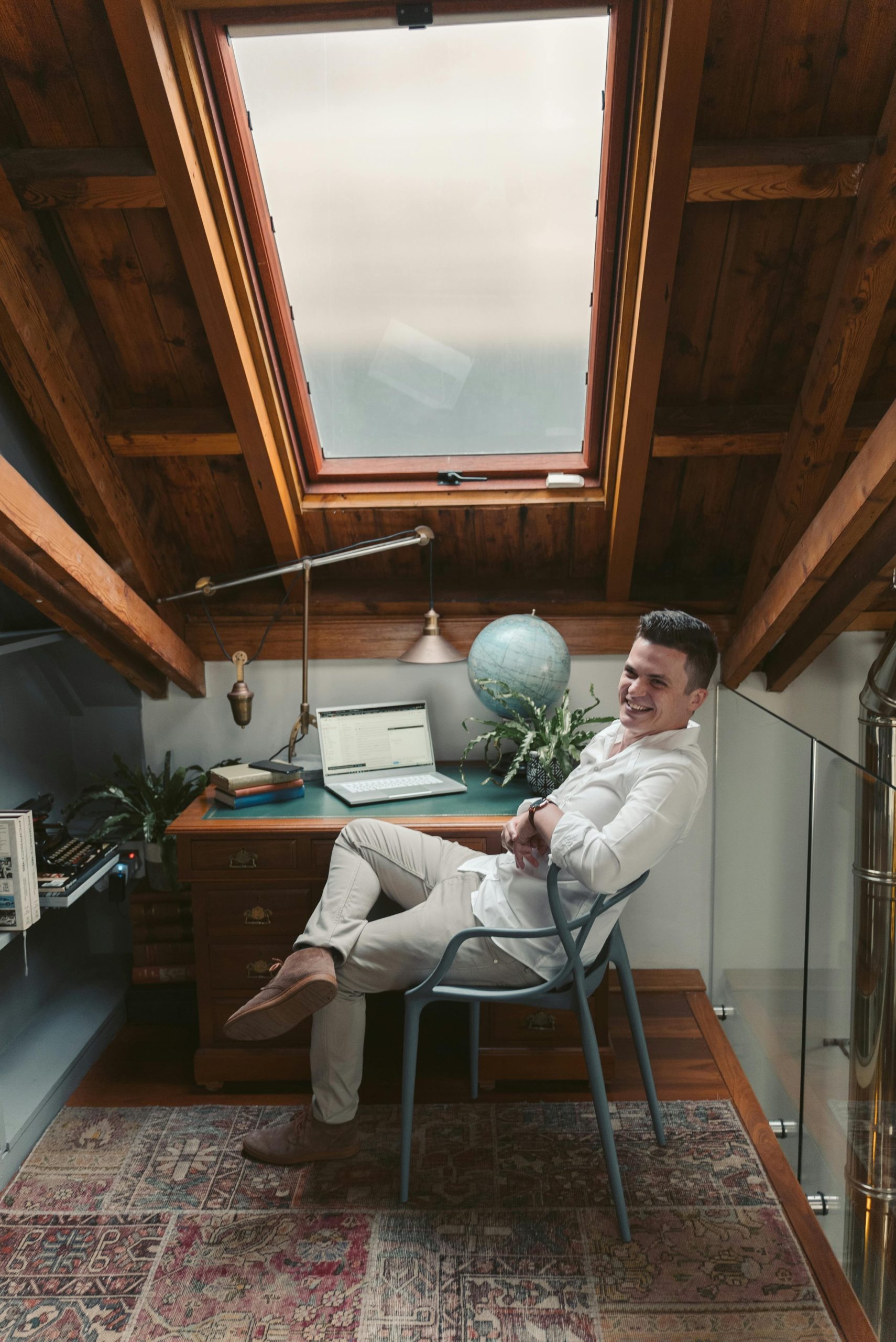Finding the perfect skylight for your pitched roof involves balancing style, performance, and practicality. Designed for slopes between 6° and 45°, these triple-glazed rooflights offer exceptional thermal insulation and noise reduction. With smart glass technology and electric blinds, they enhance comfort and energy efficiency, while installation kits simplify fitting. Tailored solutions bring natural light and quiet to your home, combining modern design with lasting value.
Understanding Skylights for Pitched Roofs
Skylights Designed for Pitched Roofs are an excellent way to enhance natural light and ventilation within sloped or angled roof spaces. These skylights come in various types and configurations, tailored specifically to meet the demands of pitched roofs with slopes typically ranging between 6° and 45°. The main options include fixed skylights, which do not open, and vented models that enable airflow and fresh air circulation.
In the same genre : How to Use Technology to Plan the Perfect Home Garden in the UK?
Benefits of Installing Skylights on Pitched Roofs
Installing skylights on pitched roofs offers multiple advantages. First, they significantly improve natural lighting, reducing the need for artificial lights during daytime. This can lead to noticeable energy savings and a more inviting ambiance. Second, skylights provide excellent ventilation, especially when fitted with opening mechanisms, contributing to better air quality and temperature regulation. Moreover, they enhance the aesthetic appeal of interiors by forging a connection with the outdoors, making spaces feel larger and more open.
Considerations for Homebuyers and Renovators
When selecting skylights, it’s important to consider the type of roof, the size, and placement to maximise light while avoiding issues like overheating or leaks. Pitched roof skylight types range from small, discreet models suitable for bathrooms or closets, to large, panoramic designs ideal for living rooms or attics. The decision should also factor in the specific roof pitch and compatibility with existing roofing materials. For added comfort and energy efficiency, many modern skylights feature triple glazing and smart technologies that dynamically adjust heat and light transmission.
In the same genre : Exceptional cosmetic dentistry services in Leeds
Types of Skylights Designed for Pitched Roofs
Fixed Skylights for Pitched Roofs
Fixed skylights are installed in a stationary position, making them a popular choice for pitched roof skylight installation where continuous, low-maintenance daylight is desired. Using glazing tailored for energy efficiency, these designs introduce increased levels of natural light benefits through pitched roof skylights into your space. Their non-opening nature simplifies waterproofing for sloped roofs and reduces risk of leaks, as there are fewer seams and moving parts. Preferred for attics, stairwells, and high ceilings, fixed skylight types for pitched roofs complement spaces that require enhanced sunlight but not extra airflow. High-performance triple glazed units, for instance, offer noise insulation and thermal comfort—crucial for preserving a consistent indoor temperature and reducing heating or cooling costs. Selecting advanced skylight materials suitable for pitched roofs, such as toughened or laminated glass, also extends durability and boosts energy savings on pitched roofs.
Vented and V-Skylights
Vented skylights are designed to open—either manually, electrically, or via solar-powered mechanisms—allowing homeowners to harness the advantages of pitched roof skylight ventilation. These options are ideal for spaces prone to excess humidity, like bathrooms and kitchens, as well as attic rooms where air circulation can otherwise be limited. The skylight types for pitched roofs here encompass both top-hung and centre-pivot varieties, with differing opening ranges and controls. Electric skylight openers for pitched roofs provide further convenience, integrating with automation systems for effortless ventilation and enhanced comfort. V-Skylights—a term often used for venting models—help prevent condensation issues on sloped roofs while maintaining the vitality of interior air. Materials for these opening skylights are rigorously engineered to retain energy efficiency, boasting tight seals and compatible flashing kits that excel at skylight waterproofing for sloped roofs.
Customizable and Specialty Skylights
Unique roof geometries, conservation needs, or heritage buildings require specialist solutions. Customizable and specialty skylight types for pitched roofs address these requirements, offering tailored designs that ensure compatibility with roof pitch and construction style. Conservation skylights replicate period-accurate aesthetics while incorporating modern energy-efficient glazing for sloped roofs, safeguarding building character and boosting comfort. Solutions such as bespoke sizes or custom frame materials—ranging from high-spec aluminium to traditional timber—allow for seamless pitched roof skylight installation on nonstandard roof slopes, including challenging angles or unusual tiles. These products adhere to strict skylight materials suitable for pitched roofs standards, ensuring reliable performance, longevity, and integration with existing structures. By leveraging customization, homeowners can achieve optimal daylighting design and insulation, rejuvenating historic homes while enhancing value and efficiency through advanced glazing and robust weatherproofing.
Installation Guides and Technical Considerations
Preparing the Roof and Choosing the Correct Skylight Size
Selecting the right skylight size is guided by floor area. As recommended, the glazed area should be 5–15% of the room’s floor area to balance natural light and maintain energy efficiency. Oversized units may result in unwanted heat loss or gain, so careful measurement is the first step. It’s important to match the chosen skylight windows for pitched roofs to the roof pitch and skylight compatibility rating provided by manufacturers. Always confirm that the installation will fit your framing and roofing structure.
For pitched roof skylight installation projects, consider both daylight requirements and privacy needs. Conversely, when energy-efficient skylights for sloped roofs are desired, triple glazing and low-U-value choices improve insulation and reduce energy consumption. Additionally, noise insulation can be addressed by selecting glazing that dampens external sound, further enhancing comfort beneath pitched roofs.
Step-by-Step Installation Process
Begin by outlining the skylight opening from inside the loft, confirming final dimensions against manufacturer’s guidelines. Cut the roof opening carefully, preserving rafters and insulation as needed for structural integrity and thermal performance. Preassemble the skylight flashing for pitched roofs—these kits are crucial for waterproofing. Many pitched roof skylight installation kits will supply all required components, including flashings, screws, and seals tailored for different tile or slate profiles.
Place the skylight frame in position, ensuring a snug fit and correct incline matching the specified roof pitch and skylight compatibility. Secure with brackets according to instructions, sealing around the frame with waterproof membranes or tapes. Once the frame is fixed, install the glazing and assemble the flashing kits—tile, slate, or recessed options are used based on roof type. Proper sealing at every step prevents leaks and maintains the energy-efficient skylights for sloped roofs within performance parameters.
Common Challenges and Solutions
Leaks and condensation are two main challenges in pitched roof skylight installation. To address water ingress, double-check all flashings and use high-quality waterproof sealant around all junctions. In colder months, condensation can accumulate if the skylight isn’t well insulated. Energy-efficient skylights for sloped roofs with triple glazing help minimize this risk, but regular maintenance and inspection of seals remain essential.
Structural issues may surface if rafters are cut or framing is not reinforced during installation. Consult building codes and manufacturer guides to ensure compliance. For long-term performance, always follow proper skylight flashing for pitched roofs procedures, using membranes, tape, and fastenings designed for robust waterproofing and wind resistance.
With the right product choice and careful adherence to technical steps, roof pitch and skylight compatibility is maintained, and skylight windows for pitched roofs provide years of natural light, comfort, and energy savings.
Materials, Brands, and Product Selection
High-Quality Frame and Glass Options
Selecting skylight materials suitable for pitched roofs is pivotal for performance and comfort. Leading products typically use wooden, PVC, or aluminum frames. Wooden frames, often crafted from kiln-dried pinewood, are valued for their natural insulation and aesthetic warmth. PVC frames provide superior resistance to moisture and rot, making them highly durable, particularly in humid environments. Aluminum frames, meanwhile, offer lightweight strength and demand little maintenance—ideal for contemporary settings.
For glass, both double and triple glazing remain common, but energy-efficient skylights for sloped roofs now favour triple glazing for its lower U-values and improved thermal insulation. Enhanced glazing options minimise heat loss in winter while reducing solar gain in summer, key for energy savings on pitched roofs. Many advanced models also integrate lamination or toughening, boosting safety and extending the skylight glazing lifespan for pitched roofs. Such configurations also yield better noise insulation, softening rain impact and blocking external sounds—perfect for bedrooms or living spaces under sloped roofs.
Recognized Brands and Their Offerings
When assessing skylight brands suitable for pitched roofs, established names such as Velux, Fakro, and Optilook frequently emerge due to their reliable product lines and adherence to rigorous standards like EN 14351-1 and CE. These brands cater to a spectrum of requirements with their varied ranges:
- Velux offers energy-efficient skylights for sloped roofs with modern automation options, UV protection, and self-cleaning features—streamlining maintenance and optimising light intake.
- Fakro supplies centre-pivot and top-hung varieties, often with laminated or toughened glazing. These improve both durability and security.
- Optilook specialises in moisture-resistant frames and robust flashing systems that ensure waterproof installation on roof pitches from 6° to over 45°, enhancing both safety and longevity.
Features like integrated blinds (manual or electric) and smart glass are increasingly common, enabling tailored daylight control, privacy, and further energy efficiency—making these selections especially suitable for pitched roof renovation or new builds.
Pricing, Warranties, and Delivery
Cost drivers for skylight windows for pitched roofs include size, frame material, glazing complexity, and accessories (like solar or electric blinds). Triple glazing and advanced automation raise initial investment but deliver superior thermal and acoustic benefits, as well as long-term savings on heating and cooling.
National retailers highlight competitive pricing, often VAT-inclusive, and outline warranty terms up to 20 years for some brands, though a standard 2-year warranty applies for others. This provides dependable protection against faults or manufacturing issues—critical for such a structural investment.
Delivery options span fast-track next-day availability (notably within the London M25) to free nationwide shipping across the UK within 3–6 working days. This flexibility ensures customers across the country can access best-in-class skylight materials suitable for pitched roofs, backed by efficient support and after-sales service. Custom skylight solutions for unique pitched roofs are also within reach through personalised product configuration, ensuring that both standard and bespoke requirements are met seamlessly.
Benefits and Practical Applications
Enhancing Natural Light and Ventilation
Precision in design places skylight windows for pitched roofs at the heart of modern daylighting solutions. Carefully planned pitched roof skylight installation achieves optimal natural light benefits through pitched roof skylights, reducing the need for artificial lighting during daylight hours. Strategic skylight placement maximizes morning and afternoon sun, delivering natural illumination deeper into the interior while diminishing shadowed spaces often found in homes with standard roof structures.
Ventilation skylights for pitched roofs are another essential option. The ability to introduce fresh air by opening certain units supports healthier indoor environments and can significantly improve air quality. Incorporating vented or opening skylight windows for pitched roofs allows for passive cooling—especially beneficial in upper stories or attic conversions. This approach not only leverages the natural stack effect to draw out stagnant air but also supports energy-efficient skylights for sloped roofs by limiting reliance on mechanical cooling.
Energy Efficiency and Cost Savings
Pitched roof skylight installation with triple glazed, energy-efficient skylights for sloped roofs presents tangible energy savings on pitched roofs. Each layer of glazing—especially at a U-Value as low as 1.9 W/m²K—minimizes heat transfer, keeping interiors warm in winter and cool in summer. Such configurations reduce heating and cooling demands, translating into lower energy bills. Selecting the best skylights for pitched roofs often means choosing models with advanced seals and insulated frames, aiming to further prevent thermal bridging and condensation issues common to less advanced designs.
Natural light benefits through pitched roof skylights extend beyond ambiance, as daylight is one of the most cost-effective illuminators available, offsetting substantial lighting costs over a year. If energy expenditure is a concern, prioritize skylight windows for pitched roofs with features like self-liquid smart glass technology, optimizing light levels and heat transmission based on sun and season.
Aesthetic and Structural Enhancements
Selecting the best skylights for pitched roofs provides not only superior internal conditions but also upgrades external appeal. Thoughtful skylight design ideas for pitched roofs take into account roof pitch and skylight compatibility, roofing material, and the size and layout of rooms below. Harmonious integration can define contemporary aesthetics or preserve historic charm, with customized solutions ensuring each skylight aligns perfectly with structural lines.
Structurally, modern skylight windows for pitched roofs are engineered for both durability and seamless incorporation with existing roof frameworks. Enhanced glazing options, robust flashing, and waterproofing further protect against water ingress and help maintain structural integrity during severe weather. This makes skylight windows for pitched roofs a prudent choice for those seeking to enhance property value—homes and businesses alike can benefit from the improved atmosphere, energy savings on pitched roofs, and visual impact delivered by quality installations.
Skylight Windows for Pitched Roofs: Options, Installation, and Performance
Skylight windows for pitched roofs provide significant advantages in both form and function. Precision in product selection, installation, and maintenance is essential to maximize benefits such as consistent daylighting, improved air quality, and robust energy savings.
Best Skylights for Pitched Roofs: Types and Materials
A wide variety of pitched roof skylight types are available, tailored to accommodate roof pitches from 6° to 45°. Triple-glazed rooflights, known for their superior energy efficiency and noise reduction (with soundproofing up to 39 dB), lead the market. Key materials suitable for pitched roofs include reinforced pinewood, aluminium, and multi-layered glazing. The choice of skylight glazing options for sloped roofs—such as toughened, laminated, or self-liquid smart glass—directly impacts the window’s thermal performance, insulation, and longevity.
Pitched Roof Skylight Installation Process
Effective pitched roof skylight installation is determined by the integration of flashing kits and waterproof membranes compatible with the roof type. A proper installation ensures seamless skylight waterproofing for sloped roofs, reducing risks of leaks and condensation issues. The installation process is straightforward for experienced contractors and can often be completed within a single day. However, precise skylight framing for pitched roofs and the use of reliable skylight sealants for pitched roof applications are essential to maintain weather-resistance and insulation.
Energy Efficiency and Design Choices
When choosing energy-efficient skylights for sloped roofs, opt for triple-glazed or high-quality double-glazed units with low U-values and advanced coatings. This minimizes heat loss in winter and excess heat gain in summer, contributing to lower heating and cooling costs. Thoughtful placement and selection of skylight size recommendations for pitched roofs—commonly 5-15% of the room’s floor area—maximize the natural light benefits through pitched roof skylights without excessive glare or thermal imbalance.
Maintenance and Common Considerations
Maintenance of skylights on pitched roofs requires regular inspection of glazing, flashings, and seals to pre-empt issues like leaks or condensation. Modern models with condensation-resistant coatings, as well as accessible cleaning designs, extend product lifespan and performance. Condensation is a common pitched roof skylight problem; good ventilation skylights for pitched roofs and routine seal checks reduce risks.
Installation Costs and Value
The cost of installing skylights on pitched roofs depends on product type, customisation, roof complexity, and accessory selections. Factors such as advanced glazing and solar-powered blinds may increase initial outlay, but these features drive long-term energy savings. Competitive pricing is available for standard models, and many suppliers provide cost-effective solutions balanced with high-end features and multi-year warranties.
Aesthetic and Functional Enhancements
Skylight design ideas for pitched roofs encompass not only fixed and vented models but also electric blinds and smart control systems for custom light management. Custom skylight solutions for unique pitched roofs enable homeowners to improve architectural aesthetics and room function, while also securing lasting thermal and acoustic benefits.
By carefully balancing product features, installation techniques, and maintenance schedules, pitched roof skylights become a smart investment for energy efficiency, home value, and everyday comfort.











